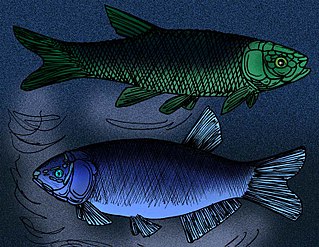
The Tetraodontiformes are an order of highly derived ray-finned fish, also called the Plectognathi. Sometimes these are classified as a suborder of the order Perciformes. The Tetraodontiformes are represented by 10 extant families and at least 349 species overall; most are marine and dwell in and around tropical coral reefs, but a few species are found in freshwater streams and estuaries. They have no close relatives, and descend from a line of coral-dwelling species that emerged around 80 million years ago.

Deinosuchus is an extinct genus of alligatoroid crocodilian, related to modern alligators and caimans, that lived 82 to 73 million years ago (Ma), during the late Cretaceous period. The name translates as "terrible crocodile" and is derived from the Greek deinos (δεινός), "terrible", and soukhos (σοῦχος), "crocodile". The first remains were discovered in North Carolina in the 1850s; the genus was named and described in 1909. Additional fragments were discovered in the 1940s and were later incorporated into an influential, though inaccurate, skull reconstruction at the American Museum of Natural History. Knowledge of Deinosuchus remains incomplete, but better cranial material found in recent years has expanded scientific understanding of this massive predator.

Syngnathus is a genus of fish in the family Syngnathidae found in marine, brackish and sometimes fresh waters of the Atlantic, Indian and Pacific Ocean. Fossils of these species are found from the Oligocene to the Pleistocene. They are known from various localities of Greece, Italy, Germany and United States.
The Chattian is, in the geologic timescale, the younger of two ages or upper of two stages of the Oligocene Epoch/Series. It spans the time between 27.82 and23.03 Ma. The Chattian is preceded by the Rupelian and is followed by the Aquitanian.

Paleobiology is an interdisciplinary field that combines the methods and findings found in both the earth sciences and the life sciences. Paleobiology is not to be confused with geobiology, which focuses more on the interactions between the biosphere and the physical Earth.

Ailuravus is a genus of prehistoric rodents in the family Ischyromyidae.

Uarbryichthys is a genus of primitive ginglymodian ray-finned fish from fossil beds near the Talbragar River Bed. The various species were lake-dwelling fish that lived during the Upper Jurassic of Australia, and are closely related to the macrosemiids. The living animal would have had a superficial resemblance to a very small porgie, scup, or sea bream, but with a heterocercal tail fin.
Plectocretacicus is an extinct genus of prehistoric ray-finned fish that lived during the lower Cenomanian. It contains a single species, P. clarae. Plectocretacicus is the earliest known member of the order Tetraodontiformes.

Eubiodectes is an extinct genus of prehistoric bony fish that lived during the Cenomanian.

Cretatriacanthus is an extinct genus of prehistoric marine ray-finned fish from the Late Cretaceous. It contains a single species, C. guidottii from the late Campanian or early Maastrichtian of Nardò, Italy. It is generally placed as a basal tetraodontiform, although more recent studies have disputed this, finding it to instead represent an early basal percomorph.
Dialipina is an extinct genus of prehistoric, marine osteichthyan. It was initially thought to be an early, basal actinopterygian, but recent phylogenetic analyses suggest that it may instead be a stem-osteichthyan.

Wadeichthys oxyops is an extinct archaeomaenid bony fish from the Koonwarra Lake fauna of Lower Cretaceous Victoria, Australia. If the related genus Koonwarria is regarded as being in a different family, then W. oxyops is the only known Cretaceous-aged archaeomaenid from Australia.
Westollia is an extinct genus of prehistoric bony fish that lived during the Asselian age in what is now Thuringia, Germany.
Willomorichthys is an extinct genus of prehistoric bony fish that lived during the Carboniferous period in what is now South Africa. Fossils were recovered from the Upper Witteberg Series.
Urosthenes is an extinct genus of prehistoric bony fish that lived during the Lopingian to Middle Triassic epochs in what is now New South Wales, Australia.
Sundayichthys is an extinct genus of prehistoric bony fish that lived during the Carboniferous period in what is now South Africa. Fossils were recovered from the Upper Witteberg Series.
Korutichthys is an extinct genus of prehistoric marine bony fish that lived during the Lopingian epoch in what is now Krasnoyarsk Krai, Russia. It was first referred to the family Amblypteridae, a view that was later questioned.

Phanerosteon is an extinct genus of prehistoric bony fish from the Carboniferous period. The type species, P. mirabile, was recovered from the Calciferous sandstone series (Pennsylvanian), Scotland. A second species, P. phonax was described from the Serpukhovian aged Bear Gulch Limestone lagerstätte in Montana, United States.
Kinkonychelys is an extinct genus of side-necked turtle which existed in Madagascar during the Late Cretaceous period. It contains the single species Kinkonychelys rogersi, named in honor of its discoverer, Raymond R. Rogers. The genus and species are based on UA 9748, a nearly complete skull, which represents the first turtle skull described from the pre-Holocene era in Madagascar. A number of isolated skull and jaw bones have also been assigned to K. rogersi. These specimens were found in rocks of the Maastrichtian-age Maevarano Formation in the Mahajanga Basin of northwestern Madagascar. Another specimen, FMNH PR 2446, is speculated to represent another species, currently known as Kinkonychelys sp., but consensus on its distinction from K. rogersi remains unclear.
Cretatriacanthidae is an extinct family of prehistoric marine ray-finned fish from the Late Cretaceous. It contains two genera, both known from southern Europe.









